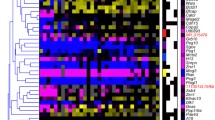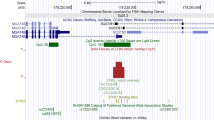Abstract
The four genesIGF2, H19, SNRPN andZNF127 are imprinted in mouse and human.IGF2 andH19 form one conserved cluster on the distal part of mouse chromosome 7 and human chromosome 11p15.5, whereasSNRPN andZNF127 form another on the middle of mouse chromosome 7 and on human chromosome 15q11-13. We have explored the evolution of these imprinted regions by cloning and mappingIGF2, H19, SNRPN andZNF127 homeologues in marsupials. Specifically, we wished to determine whether the arrangements were shared in eutherian and marsupial mammals, and to determine whether they lay on autosomes, or on the X, as might be predicted by the hypothesis that imprinting evolved from X inactivation. Using fluorescencein situ hybridization, we localized the marsupial homeologues ofIGF2 andH19 to the distal part of tammar wallaby chromosome 2p and the marsupial homeologues ofSNRPN andZNF127 to the middle of chromosome 1q. Thus, these genes were originally organized in two separate autosomal clusters in the therian ancestor 180 million years ago, the conservation of which may suggest a functional relationship. The autosomal location of these clusters does not suggest a recent evolutionary relationship between imprinting and X chromosome inactivation.
Similar content being viewed by others
References
Bartolomei MS, Zemel S, Tilghman SM (1991) Parental imprinting of the mouse H19 gene.Nature 351: 153–155.
Cooper DW, VandeBerg JL, Sharman GB, Poole WE (1971) Phosphoglycerate kinase polymorphism in kangaroos provides further evidence for paternal X inactivation.Nature New Biol 230: 155–157.
DeChiara TM, Robertson EJ, Efstratiadis A (1991) Parental imprinting of the mouse insulin-like growth factor II gene.Cell 64: 849–859.
Glaser T, Housman D, Lewis WH, Gerhard D, Jones C (1989) A fine-structure deletion map of human chromosome 11p: analysis of J1 series hybrids.Som Cell Mol Genet 15: 477–501.
Henry I et al. (1991) Uniparental paternal disomy in a genetic cancer-predisposing syndrome.Nature 351: 665–667.
Hope RM, Cooper S, Wainwright B (1990) Globin macromolecular sequences in marsupials and monotremes. In: Graves JAM, Hope RM, Cooper DW, eds.Mammals from Pouches and Eggs: Genetics, Breeding and Evolution of Marsupials and Monotremes. Melbourne: CSIRO Press, pp 147–171.
Leff SE, Brannan CI, Reed ML et al. (1992) Maternal imprinting of the mouseSnrpn gene and conserved linkage homology with the human Prader-Willi syndrome region.Nature Genet 2: 259–264.
Lichter P, Cremer T, Borden J, Manuelidis L, Ward DD (1988) Delineation of individual human chromosomes in metaphases and interphase cells byin situ suppression hybridization using recombinant DNA libraries.Hum Genet 80: 224–234.
Maccarone P, Watson JM, Francis D et al. (1992) The evolution of human chromosome 21: evidence fromin situ hybridization in marsupials and a monotreme.Genomics 13: 1119–1124.
Motirangura A, Jayakumar A, Sutcliffe JS et al. (1993) A complete YAC contig of the Prader-Willi/Angelman chromosome region (15q11-q13) and refined localization of theSNRPN gene.Genomics 18: 546–552.
Moore T, Haig D (1991) Genomic imprinting in mammalian development: a parental tug-of-war.Trends Genet 7: 45–49.
Nicholls RD (1993) Genomic imprinting and candidate genes in the Prader-Willi and Angelman syndromes.Curr Opin Genet Dev 3: 445–456.
Nicholls RD, Gottlieb W, Russell LB et al. (1993) Evaluation of potential models for imprinted and nonimprinted components of human chromosome 15q11-q13 syndromes by finestructure homology mapping in the mouse.Proc Natl Acad Sci USA 90: 2050–2054.
Schempp W, Meer B (1983) Cytologic evidence for three human X-chromosomal segments escaping inactivation.Hum Genet 63: 171–174.
Sharman GB (1971) Late DNA replication in the paternally derived X chromosome of female kangaroos.Nature 230: 231–232.
Sinclair AH, Graves JAM (1991) Gene mapping in marsupials: detection of an ancient autosomal gene cluster.Genomics 9: 581–586.
Takagi N, Sasaki M (1975) Preferential inactivation of the paternally derived X chromosome in the extraembryonic membranes of the mouse.Nature 256: 640–642.
Toder R, Zeitler S, Goodfellow PN, Schempp W (1993) Comparative mapping ofSRY in the great apes.Chromosome Res 1: 117–120.
Toder R, Rappold GA, Schiebel K, Schempp W (1995)ANT3 andSTS are autosomal in prosimian lemurs: implications for the evolution of the pseudoautosomal region.Hum Genet 95: 22–28.
Wilcox SA, Toder R, Foster JW (1996) Rapid isolation of recombinant lambda phage DNA for use in fluorescentin situ hybridization.Chrom Res (in press).
Zemel S, Bartolomei MS, Tilghman SM (1992) Physical linkage of two mammalian imprinted genes, H19 and insulin-like growth factor 2.Nature Genet 2: 259–264.
Author information
Authors and Affiliations
Corresponding author
Additional information
accepted for publication by M. Schmid
Rights and permissions
About this article
Cite this article
Toder, R., Wilcox, S.A., Smithwick, M. et al. The human/mouse imprinted genesIGF2, H19, SNRPN andZNF127 map to two conserved autosomal clusters in a marsupial. Chromosome Res 4, 295–300 (1996). https://doi.org/10.1007/BF02263680
Received:
Revised:
Accepted:
Issue Date:
DOI: https://doi.org/10.1007/BF02263680




